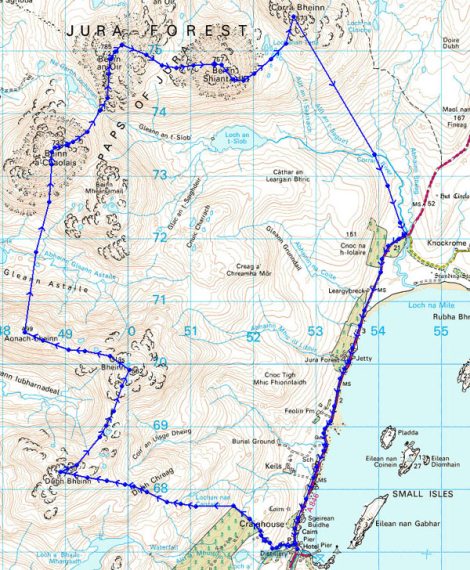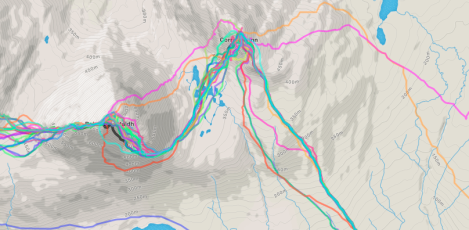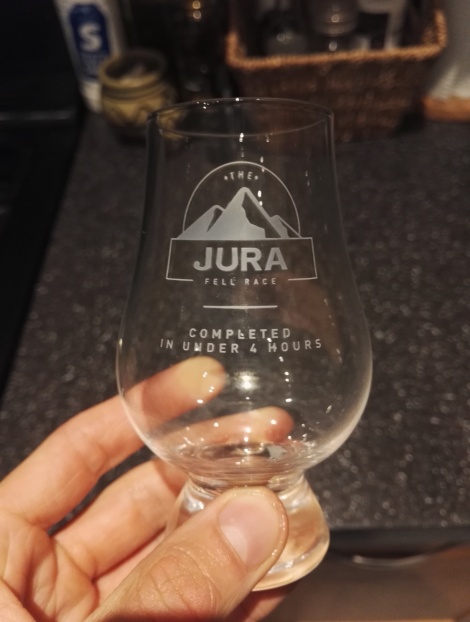I first went to Jura in 2011. I put my postal entry in with a note saying that although I’d only run one hill race, Pentland Skyline, I was planning on running Stuc a’Chroin in April so could I pretty please have a place. Graham Arthur had his eye on the ball and my confirmation email arrived as I lay, asleep, on the gravel outside my dad’s house, having been absolutely annihilated by Stuc. They were simpler times. Times when phrases like online entry, pre-selection list and electronic timing chip did not form a part of the Jura organiser’s lexicon.

Unsurprisingly, Jura wiped the floor with me. Staggering off Beinn Shiantaidh, utterly spent, I would have dropped out if there had been a convenient way of doing so. Rescued from the brink of oblivion by a mini Mars bar, kindly donated by a Carnethy runner on the descent to 3 Arch Bridge, I felt like crying all the way to Craighouse, somehow still making it back without giving in to the sweet release of death.
My three runs at Jura since then blend into one, characterised as they all were by a wretched failure to deal with the heat, on top of all the usual failings. Twice I arrived dead set on getting under 4 hours, only to be undone by the windless oven on the east side of Beinn Shiantaidh. In the hot, still air I wilted, able only to watch as runner after runner, as well as my chances of claiming a much coveted whisky glass, disappeared into the distance.
Even my most recent run, in 2016, was something of a failure. Almost half an hour from my PB and a home for a dram at last, but with more commonalities than differences with previous runs. As before, I joined the parade of the walking wounded on the road to Craighouse, trading places back and forth with Andy Barrington as we took turns succumbing to staccato fits of cramp. I ran several hundred metres backwards. At one point I ended up in the ditch. When the finish finally came, Andy pushed me over the line ahead of him, neither of us willing to accept that we deserved to be before the other.
*****
I won’t say that Jura is the hardest hill race. What about Wasdale? cry the Lakeland zealouts. But its brutality is unique.
Adrenaline carries you up the first few hundred metres of wiggly track, then reality bites as you skirt a patch of forestry. If that bit of bog were ever to dry it could only be interpreted as a sign of impending apocalypse. Any runner who makes it through without looking like they’ve been hip deep in shit is to be viewed with suspicion.
The run through the Pips is tough, but it is only an amuse-bouche before the main course of the Paps. They’re not the biggest hills but they punch well above their weight. Steep, rough, rocky; they’ll cover your shins with blood and fill your shoes and your palms with scree. Get it wrong and you’ll be picking bits out of your ears for weeks.
Debate rages about the best line off Beinn Shiantaidh. Smug veterans nod knowingly. There are minutes to be made here for those with the least worst lines. Cross Smithy’s palm with Guinness, he’ll give you a clue.
The likely, unfortunate truth: it’s all shit. Suck it up and run.

Ok, who didn’t read the race briefing?
The final descent is a lie. It’s longer, rockier, boggier. It isn’t even all downhill. You’ve come this far without incident, you think you’ve nailed it, you’re home and dry. But, as Ben Franklin said,
in this world nothing can be said to be certain, except death, taxes and getting fucking cramp as your cross the Corran River.
And then there’s the road.
Or, to give it its proper title, That Fucking Road. Or the Craighouse Parkrun. The six inch nail in Jura’s crown of thorns.
Climbing and descending 2,400m in 22k is no-one’s recommended warmup for a flat 5k, but that’s what runners of the Jura Fell Race have to work with. For many, the transition from hardcore hill slog to road running leg speed is too much. Their eyes roll back in their heads, strange, primeval grunts rise from their throats, drool reaches from the corners of their mouths to the lives of their ears like bunting at a birthday party. Still they fall onward, because there is nothing else to be done.
There’s a cattle grid. There’s a 1 metre rise as the road crosses a bridge. There’s the infamous “Craighouse 1 Mile” sign, the cruelest lie in hill running. Every one a spear in your side as you stagger through your own personal Calvary. And through it all, the distillery chimney stands stubbornly in the distance. Visible for miles, it never, ever gets closer.
*****
I’m ambivalent about my run this year. 3:40 in wind, rain and clag. A 6 minute improvement on my 2016 time and a full hour faster than my 2011 debut.

I went in intent on having A Good Run; no cramping up on the road, no navigational howlers, no bonks, just a solid, respectable performance. I also wanted an enormous personal best. In hindsight, these two notions were probably incompatible. Taking the former too seriously scuppered the chances of the latter.
A little too casual at the start, a little too conservative climbing the Paps, a little too slow (again) picking my way through the greasy boulders of Beinn Shiantaidh.
But there are positives too. A fifth personal best in a row in crap conditions, a massive improvement in my Craighouse Parkrun time and, most important of all, motivation to come back next year.
Because that’s what Jura is like. For all its sadism, it’s a race that draws people back again and again. Convenient for no-one save the tiny handful of Jura and Islay locals that run each year, Craighouse is a site of pilgrimage for Mudclaw wearers everywhere. Despite only being an annual event since 1983, there are 13 people who have run 21 or more Jura Fell Races. Albert Sunter ran his 30th this year. He runs for Lostock, just outside Bolton. Iain Holmes, a six time winner, ran his 23rd, every one under 4 hours. I can only assume that these days his whisky glasses just go straight in the recycling.
The list of past winners and the holders of the various records is a Who’s Who of present and past hill running greatness. Jura draws national champions, world champions, Olympians, Piolet D’Or winners and part-time bar staff.
And unlike many races where everyone buggers off as soon as the cramp’s subsided, these people are trapped, with no choice but to cram themselves cheek by jowel in the hotel bar and noisily argue about the merits or otherwise of switching to road shoes for the run to the finish.
Millingaround the campsite on Sunday morning, blearily exchanging notes on the race, and the après-race, is as much a part of the weekend as the running itself. Jura isn’t popular in spite of its inconvenience, it’s popular because of it.
On the boat back to Tayvallich, the Paps gradually disappear from view, taking with them the memory of the suffering. You remember you suffered, but the substance of it fades. If you could book next year’s ferry the instant you step back onto the jetty on the mainland, many would.
*****
Many, but not everyone. There are some, just one or two, for whom Jura is too much. When Don Ritchie, one of the best runners the UK has ever produced, ran the inaugural race in 1973. He had this to say about it.
On the 14th of July, I had a very hard time in the ‘Bens of Jura’ race of 16 miles over 7 mountain summits, including the ‘Paps of Jura’ for a total of 7500 feet of ascent and descent. My diary entry was: The course was dreadful and if I had seen it properly before the race I probably would not have started it. On Friday there was a mist so I could not see more then the third hill. I started quite easily and at the first top I was 3rd and within catching distance of the leaders. I maintained this gap until the third top, but when I started the descent from this I had to scramble down a cliff and then 2000 feet of a scree slope. My ankles got badly banged and cut so I could not run down the scree like the others and I lost a lot of ground. I felt exasperated and decided that my aim now, must be to finish in one piece, rather than race for a high placing. I lost a couple of places going up the fourth too, but I had moved back to 4th by the top. The descent from this one was extremely dangerous and I lost more places. We were now climbing the ‘Paps of Jura’, which had very steep sides and looked a bit like volcanoes with pointy tops. At the top of the sixth, I was 7th, but the descent from this one was suicidal with a precipice most of the way around the North side. One competitor; John Marstrand started an impressive avalanche as he descended the very steep scree slope. I made my way painfully and slowly down some very steep scree. At the top of the seventh and final hill I was 8th and after stumbling down through the rough boggy ground, to reach the bridge, which was the last checkpoint, I was 9th. On the 3 miles of road to the finish at Craghouse village hall, I passed two and finished 7th in 4-29-13. Bobby Shields of Clydesdale Harriers was first in 3-54. This is a race I will not try again. I was the only non-hill-running specialist participating. At night there was a Ceilidh in the village hall, which we all enjoyed.
I could not run for the following five days because my leg muscles were far too painful.
For all his moaning, he was still one place ahead of Alan Heaton.

Loved reading this, very funny and brutally honest.